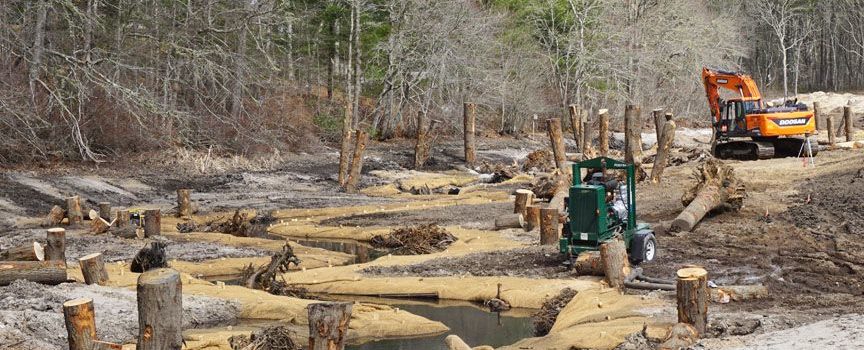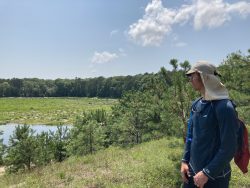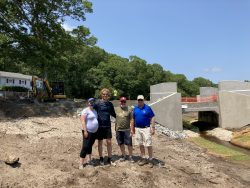
Childs River restoration making progress in Massachusetts
By Tom Ardito
On a hot July afternoon, I visited the Upper Child’s River Restoration Project on Cape Cod. The work is one of several coastal habitat restoration projects funded by the Southeast New England Program (SNEP) Watershed Grants, a partnership between the U.S. Environmental Protection Agency (EPA) and Restore America’s Estuaries (RAE).

The air hummed and the ground vibrated as workers used a small backhoe and soil compactor to bury a new concrete culvert beneath an old road in the town of Falmouth. A small, winding stream emerged from the forest at the north end of the construction site, flowed under the culvert, and disappeared back into the woods downstream. The banks of the stream were lined with biodegradable tubes made of coconut-fiber netting filled with soil, to stabilize the newly-established curves of the waterway.
The surrounding land, about ten acres, looked like a moonscape of loose dirt, with cut logs and tree-stumps placed seemingly at random – some laying on the ground, others sticking up at crazy angles. Already, however, native wetland plants were emerging from the fresh earth, germinating from seeds buried more than a century ago. Until last year, this area was an abandoned mill pond. Now, it’s being returned to a forested swamp and stream system, habitat for native Eastern brook trout and hundreds of other species, much as it was for thousands of years before Europeans began altering the landscape of Cape Cod.

Upstream, two former cranberry bogs are also undergoing restoration. Like the mill pond, the bogs were carved out of natural wetlands in the 1800’s. Restored a few months ago, they’re now covered with a dense carpet of native wetland plants, sprung from the same ancient seed bank. The little Child’s River – a stream, really, just a few feet wide for most of its course – connects all three restored wetlands, and then flows south into Waquoit Bay.
All of this work is part of the Upper Child’s River Restoration Project, one of the largest freshwater wetland restorations underway in the Northeast. The $3 million project, which will restore about 40 acres of wetlands on a 200-acre site, is funded partially by SNEP Watershed Grants. By re-establishing forested wetlands and re-connecting the watershed to the estuary, the work will restore historic habitat for fish and wildlife while improving water quality — creating cleaner, more oxygenated waters in the river and the Bay.
Leading me on the site visit were Gary Anderson and A.D. Colburn of the Falmouth Rod & Gun Club, the project leader; April Wobst of the Association to Preserve Cape Cod, the project manager; and Nick Nelson, the project designer and construction manager from Inter-Fluve, Inc. Other partners (there are many) include the Towns of Falmouth and Mashpee, the US Fish & Wildlife Service, MassWildlife and the Massachusetts Div. of Ecological Restoration.
To restore the Child’s River watershed, the partners removed the mill dam, enlarged the culvert, and used the earth-moving equipment and tree-trunks to recreate a more natural wetland topography, right down to restoring the winding stream flooded long ago by the mill pond. Upstream, the two cranberry bogs received a similar treatment – replacing gridded ditches and water-control structures with the winding streams, small ponds and hummocky terrain typical of natural swamps.
In addition to its environmental goals, the project will offer a variety of recreational benefits: trout fishing, waterfowl hunting, and hiking on new trails through the restoration site, and cleaner water for swimming, fishing and boating in Waquoit Bay. Regionally, outdoor activities such as these generate billions of dollars per year in economic value and direct expenditures. It’s a good example of the kind of project that SNEP Watershed Grants seeks to fund: technically innovative, partnership-based, and holistic in its approach, providing broad benefits to coastal ecosystems and communities in Southeast New England.



The construction phase of the Childs River restoration project is wrapping up now, with completion expected in late summer, 2021. The partners will continue the planting phase next year, installing Atlantic white cedar and other native species that are unlikely to regenerate on their own. While the design, construction and planting process took several years, full recovery of a restored wetland usually occurs over decades; therefore, the partners will monitor the site’s recovery indefinitely. Meanwhile, SNEP Watershed Grants will continue funding innovative, effective projects that restore ecosystems and communities throughout Southeast New England.
For more information about SNEP Watershed Grants or the Childs River restoration project, see www.snepgrants.org.

Tom Ardito is the Southeast New England Watershed Grant Program Director for Restore America’s Estuaries.
He is based in Rhode Island.
Photos courtesy of Falmouth Rod & Gun Club
